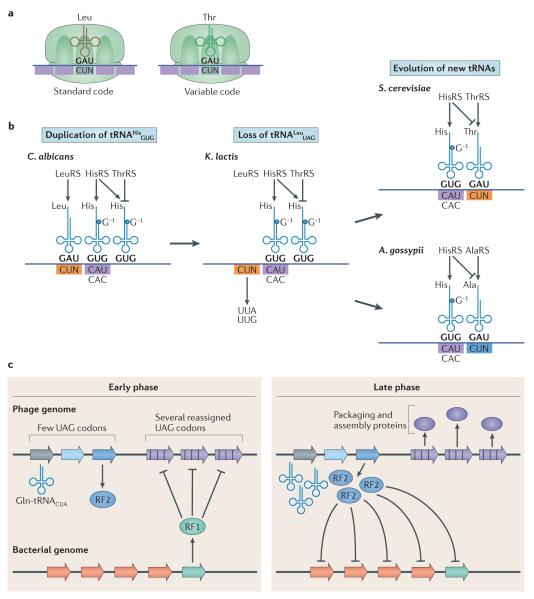Figure 3. Codon reassignment.
a ∣ CUN codons are read as Leu in the standard genetic code through the use of tRNALeuUAG. However, in some microorganisms, CUN codons have been reassigned to Thr. b ∣ CUN reassignment in mitochondria involved several steps. In the mitochondrial genome of some Saccharomycetaceae species (for example, Candida albicans), the tRNAHisGUG gene was duplicated. The CUN codons and a tRNALeuUAG that decodes CUN then disappeared, leading to a reduced genetic code, as in Kluyveromyces lactis. In Saccharomyces cerevisiae, one copy of tRNAHisGUG evolved to carry an anticodon UAG that reads CUN codons (tRNAHisUAG). The threonyl-tRNA synthetase (ThrRS) co-evolved with the tRNAHisUAG to recognize it as a tRNAThrUAG. CUN codons then reappeared to complete the codon reassignment from Leu to Thr. In Ashbya gossypii, secondary mutations enabled the new tRNAHisUAG to be recognized by AlaRS instead of HisRS or ThrRS, therefore generating tRNAAlaUAG and reassigning CUN codons to Ala in this species. c ∣ Codon reassignment can affect bacteria and phage physiology. In a phage from the human oral cavity, reassigning UAG codons to Gln may allow the phage to interfere with translation of host genes without affecting translation of the phage genes. In the early stages of infection, the phage early genes contain few in-frame UAG codons and are therefore efficiently translated by the host machinery. Among these genes, the phage expresses release factor 2 (RF2), which suppresses translation of UGA codons, including recoded ones. As the bacterial protein RF1, which suppresses translation of UAG codons, contains multiple in-frame UGA codons, expression of RF2 by the phage inhibits translation of host RF1. This inhibition allows the phage to translate late-stage phage genes, which are enriched in recoded UAG codons, while modifying the translation of host genes. Part b is adapted from Su, D., Lieberman, A., Lang, B. F., Simonovic, M., Söll, D. & Ling, J., An unusual tRNAThr derived from tRNAHis reassigns in yeast mitochondria the CUN codons to threonine, Nucleic Acids Res., 2011, 39, 11, 4866–4874, by permission of Oxford University Press. Part c is adapted from Ivanova, N. N. et al. Stop codon reassignments in the wild. Science 344, 909–913 (2014). Reprinted with permission from AAAS.

